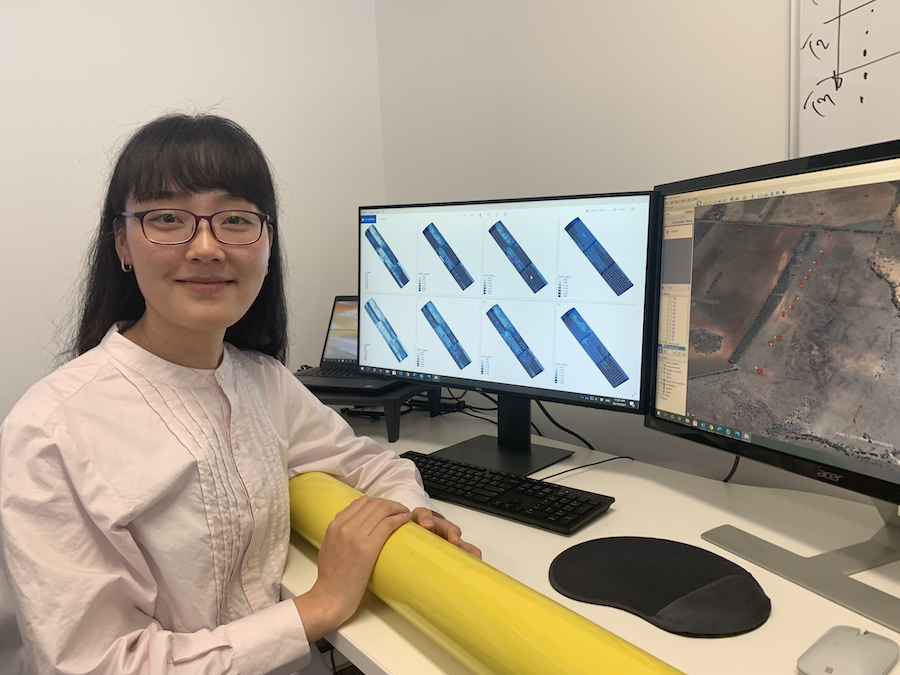Key points
- A sensor is being used to 3D map soil moisture and crop water use on-farm in sorghum trials
- It non-invasively infers crop water use and root function
- This data has provided the first evidence that relates planting time to root growth, water extraction patterns and the risk of water stress for winter-sown sorghum
- It is showing that sowing sorghum in winter in some northern regions not only decreases the risk of extreme heat during the critical flowering growth stage, but also reduces the likelihood of terminal stresses and increases the likelihood of double cropping
Attached to a long arm from an all-terrain vehicle driving across research paddocks in Queensland is a sensor with a special job. By measuring the soil apparent electrical conductivity (ECa), the sensor is non-invasively inferring crop water use and root function across sorghum trials.
This data is helping to show that sowing sorghum early, in late winter in some northern regions, not only decreases the risk of extreme heat during the critical flowering growth stage, but also reduces the likelihood of terminal stresses while increasing the likelihood of double cropping.
Initial results show that early sown sorghum yields can be similar to, or higher than, those of a main season crop.
Researchers at the Queensland Alliance for Agriculture and Food Innovation (QAAFI) have been studying how this traditional summer crop could perform as a winter crop in the GRDC-invested ‘Optimising Sorghum Agronomy’ project.
The electrical conductivity work by postdoctoral research fellow Dr Dongxue Zhao plays a part in this project. With the sensor, sorghum’s complicated water use interactions are being untangled.
Dr Zhao says the data has provided the first evidence that relates planting time to root growth, water extraction patterns and the risk of water stress for winter-sown sorghum.

Queensland Alliance for Agriculture and Food Innovation (QAAFI) postdoctoral research fellow Dr Dongxue Zhao’s electrical conductivity work with an EM27 sensor (pictured) is untangling sorghum’s complicated water use interactions. Supplied: Dongxue Zhao
Winter sorghum
Dr Zhao says sowing sorghum in winter could help avoid the high likelihood of stress occurring at sensitive crop stages. Due to climate change effects, water stress and heat at flowering are common abiotic stresses that limit sorghum yield when planted as a summer crop.
“Sowing sorghum in winter could avoid the overlap between the times of the year where there is a high likelihood of stress at a sensitive crop stage,” she says.
“However, little is known about root growth and function – that is, water use when sorghum is sown into cold soils in late winter or early spring, or how different combinations of genotypes and agronomic managements affect water use.”
Typical approaches to better understanding that, through root phenotyping in the field, are either invasive or destructive. These methods are also labour-intensive and cost-prohibitive when hundreds of plots in large on-farm genetics by management (GxM) experiments are considered.
The EM machine gets around that. Attached to one side of the all-terrain vehicle, the instrument skims across the soil, measuring ECa at four different depths: zero to 0.5 metres, zero to 1m, zero to 1.5m and zero to 3m.
This information is then interpolated across many more soil layers using machine learning approaches to produce 3D maps of soil water at multiple soil depths. From this information, soil texture, salinity and moisture can also be derived.
Dr Zhao says the information is important. “Water and heat stresses are limiting crop yields in Australia. Optimising the combination of genetics and agronomic management could improve crop water use efficiency and build resilience to drought stress. We need information on the crop water use and root function under large contrasting GxM trials.”
Crop water use and root function are highly dynamic and vary with soil depth and growth stage. A method like the one being used – enabling fast and cost-efficient screening across the whole growing season, especially at critical growth stages such as flowering – was needed.
The sensor has been used since 2019 in sorghum trials.
More information: Dongxue Zhao, 0451 731 233, dongxue.zhao@uq.edu.au

























































